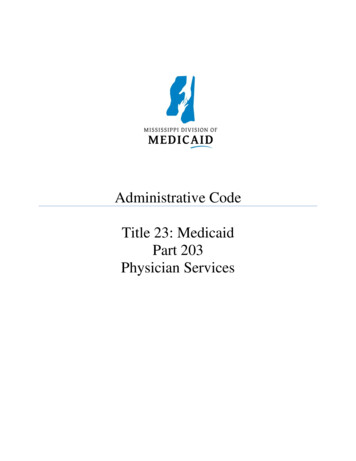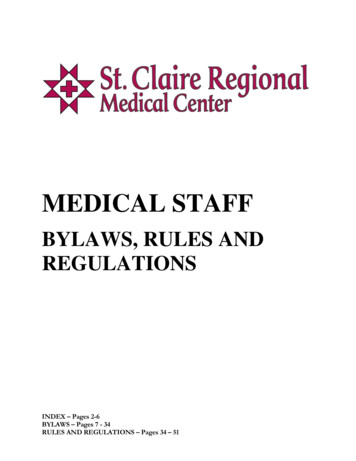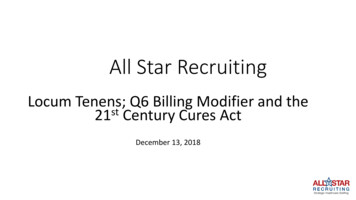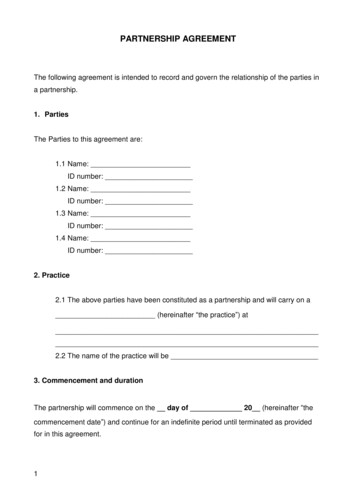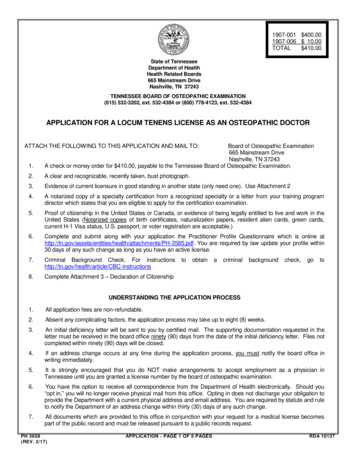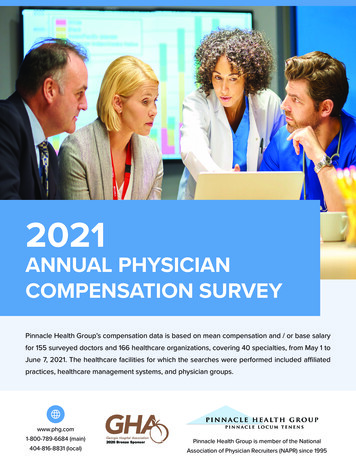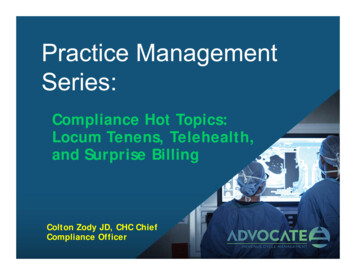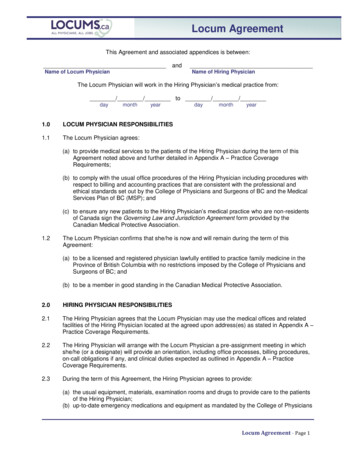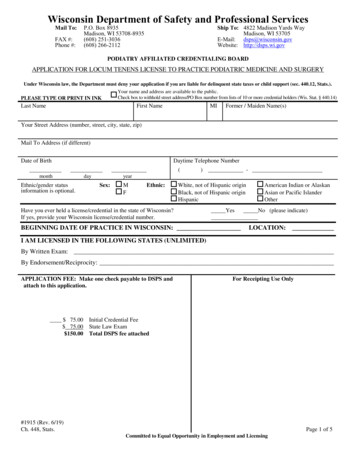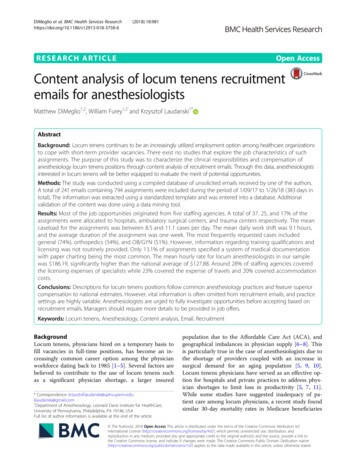
Transcription
DiMeglio et al. BMC Health Services 2018) 18:981RESEARCH ARTICLEOpen AccessContent analysis of locum tenens recruitmentemails for anesthesiologistsMatthew DiMeglio1,2, William Furey1,2 and Krzysztof Laudanski1*AbstractBackground: Locum tenens continues to be an increasingly utilized employment option among healthcare organizationsto cope with short-term provider vacancies. There exist no studies that explore the job characteristics of suchassignments. The purpose of this study was to characterize the clinical responsibilities and compensation ofanesthesiology locum tenens positions through content analysis of recruitment emails. Through this data, anesthesiologistsinterested in locum tenens will be better equipped to evaluate the merit of potential opportunities.Methods: The study was conducted using a compiled database of unsolicited emails received by one of the authors.A total of 241 emails containing 794 assignments were included during the period of 1/09/17 to 1/26/18 (383 days intotal). The information was extracted using a standardized template and was entered into a database. Additionalvalidation of the content was done using a data mining tool.Results: Most of the job opportunities originated from five staffing agencies. A total of 37, 25, and 17% of theassignments were allocated to hospitals, ambulatory surgical centers, and trauma centers respectively. The meancaseload for the assignments was between 8.5 and 11.1 cases per day. The mean daily work shift was 9.1 hours,and the average duration of the assignment was one week. The most frequently requested cases includedgeneral (74%), orthopedics (54%), and OB/GYN (51%). However, information regarding training qualifications andlicensing was not routinely provided. Only 13.1% of assignments specified a system of medical documentationwith paper charting being the most common. The mean hourly rate for locum anesthesiologists in our samplewas 186.19, significantly higher than the national average of 127.88. Around 28% of staffing agencies coveredthe licensing expenses of specialists while 23% covered the expense of travels and 20% covered accommodationcosts.Conclusions: Descriptions for locum tenens positions follow common anesthesiology practices and feature superiorcompensation to national estimates. However, vital information is often omitted from recruitment emails, and practicesettings are highly variable. Anesthesiologists are urged to fully investigate opportunities before accepting based onrecruitment emails. Managers should require more details to be provided in job offers.Keywords: Locum tenens, Anesthesiology, Content analysis, Email, RecruitmentBackgroundLocum tenens, physicians hired on a temporary basis tofill vacancies in full-time positions, has become an increasingly common career option among the physicianworkforce dating back to 1985 [1–5]. Several factors arebelieved to contribute to the use of locum tenens suchas a significant physician shortage, a larger insured* Correspondence: l.com1Department of Anesthesiology, Leonard Davis Institute for HealthCare,University of Pennsylvania, Philadelphia, PA 19146, USAFull list of author information is available at the end of the articlepopulation due to the Affordable Care Act (ACA), andgeographical imbalances in physician supply [6–8]. Thisis particularly true in the case of anesthesiologists due tothe shortage of providers coupled with an increase insurgical demand for an aging population [5, 9, 10].Locum tenens physicians have served as an effective option for hospitals and private practices to address physician shortages to limit loss in productivity [5, 7, 11].While some studies have suggested inadequacy of patient care among locum physicians, a recent study foundsimilar 30-day mortality rates in Medicare beneficiaries The Author(s). 2018 Open Access This article is distributed under the terms of the Creative Commons Attribution 4.0International License (http://creativecommons.org/licenses/by/4.0/), which permits unrestricted use, distribution, andreproduction in any medium, provided you give appropriate credit to the original author(s) and the source, provide a link tothe Creative Commons license, and indicate if changes were made. The Creative Commons Public Domain Dedication o/1.0/) applies to the data made available in this article, unless otherwise stated.
DiMeglio et al. BMC Health Services Research(2018) 18:981treated by locum general internists compared tonon-locum physicians [12–15]. Among physicians, thebelief is that the adoption of this career option will providea more equitable work-life balance, especially to youngerdoctors [16]. Some other commonly cited reasons for pursuing a career in locum tenens include schedule flexibility,high pay rate, lack of involvement in organizational politics, and opportunities for travel [5]. Earning a secondaryincome and the potential to increase retirement resourceswere additional reasons that motivated physicians to pursue locum tenens assignments [2]. Some commonly citeddrawbacks to locum tenens include the likelihood of practicing away from home, stress from the uncertainty of theassignments, lack of benefits, and burden of credentialingprocess [5, 17].There is virtually no literature characterizing the locumpositions in anesthesiology. Since physicians select locumopportunities based on chacharacteristics such as pay rate,length of assignment, and patient load, it is strange thatthis information is not publicly available [5]. A recent survey did not even mention locum tenens as a componentof the anesthesiology workforce, even though a significantminority of anesthesiologists work on a part-time basis[10, 18]. Gathering any insight into how recruitments aredone carries important data for potential applicants andhospital management. This is especially true in the field ofanesthesiology, where the potential mismatch betweena hospital's ability to provide surgery services, patient demand, and severity in interruption of anesthesiology services delivery may have a profound effect on hospitaloperations and revenue.The purpose of this study was to provide the first analysis of the anesthesiology locum tenens market throughcontent analysis of recruitment emails by staffing agencies. Content analysis of these emails should help to better characterize the locum anesthesiology market byextracting information such as assignment locations,practice characteristics, clinical duties, and compensation from recruitment emails. This data will provide anesthesiologists a benchmark for comparison of differentlocum tenens opportunities.Page 2 of 7in total). There was no attempt to communicate withany of the soliciting companies.Inclusion criteriaThe sample followed a set of inclusion criteria and theseincluded: 1) emails regarding temporary anesthesia assignments 2) e-mails recruiting for temporary, short-term positions. Therefore, emails that delivered informationregarding permanent positions, targeted recruitment ofspecialists other than anesthesiologists, and emails that included coding information were excluded from the content analysis in this study. After applying inclusioncriteria, a total of 241 emails containing 794 assignmentswere included for further analysis (46.3% of total emails).Data collectionThe content of all emails was coded using a database witha total of 82 variables. The content of the emails was analyzed by MD and WF using a standardized template. Thevariables, along with their definitions and coded values, ispresented as Additional file 1. The intercoder reliabilitywas derived from the average percent agreement among asample of five assignments and amounted to 96.39%agreement among the coded variables.Compensation was presented either as an hourly or perdiem rate. If compensation was presented as a per diemrate but the daily work hours were not provided, the perdiem rate was divided by the mean work hours of allassignments.Statistical analysisThe emails were analyzed using descriptive statistics. Median and interquartile range (IQR) of first and third quartile were reported for continuous data. Chi-Square testingwas used to evaluate the degree of association among categorical variables. Comparison of compensation by thestate was assessed using the Kruskal-Wallis test. Differences were deemed significant if the two-tailed statisticwas below 0.05. Statistica 11.0 was used to process data(Tulsa, AZ).MethodsSampleResultsThis is a cross-sectional, descriptive study that evaluateda database of emails received by one of the authors (KL).The emails included in this study were delivered afterone of the authors registered in one of the one of thelocum tenens staffing agency during the Society of Critical Care Medicine Congress in 2015. The collection ofemail was carried out after a delay period. After aneight-month lag period, a total of 521 emails were received during the period of 1/09/17 to 1/26/18 (383 daysCharacteristics of the sampleA total of 241 emails that contained 794 assignments werereceived during the period of 1/09/17 to 1/26/18 (383 daysin total). Five staffing agencies generated most of theemails with Tuesday being the predominant day for thedelivery of most emails (Fig. 1a & b). Interestingly, the seasonality of email influx was much less pronounced in theannual cycle (Fig. 1c). We did not spot an increase in anemail around holidays or during the summer.
DiMeglio et al. BMC Health Services Research(2018) 18:981Page 3 of 7Fig. 1 Most of the assignments were offered by five companies with 77% of all assignments coming from two companies (a). Tuesday was themost common day that emails were sent, and 6.9% of emails were received during the weekend (b). The highest influx of emails was observedin July while the fewest emails were received in August (c)Practice settingThe geographical distribution of the assignments is presented in Fig. 2a. From our sample, significantly morejob opportunities were available in New York (14.69%),followed by Illinois (6.05%) and Massachusetts (5.79%)(χ2 16.85; p 0.001). Conversely, no assignments wereavailable in Alaska, Rhode Island, and Utah. The hospitalsetting was the most common site for specialist recruitment(37%) followed by ambulatory surgical centers (25%), andtrauma centers (17%) (Fig. 2b) (χ2 284; p 0.001). A totalof 42 and 28% of assignments were allocated to inpatientand outpatient settings respectively, while 30% of assignments were mixed (. Level 2 trauma centers had the greatest need accounting for 45% followed by 38% in level 1trauma centers and 17% in level 3 trauma centers.Approximately 50% of email opportunities specified therole of the anesthesiologist with certified registered nurseanesthetist (CRNA) supervision far more common thanbeing a direct provider (43% vs. 7% respectively). The median number of anesthesiologists and CRNAs working atthe assignment was specified as 6 (IQR, 4–12) and 8(IQR, 3–13) respectively, but this difference wasnon-significant. Of the 13.1% of assignments specifying asystem of medical documentation, paper charting was themost common method (28.8%) followed closely by Epic (27.9%) and Meditech (12.5%) (Fig. 3a). Also, around 8%of the assignments required proficiency in multiple documentation software.Most commonly cited length of the assignment was“ongoing” which accounted for 65.6%, while 23.8% of theemails specified a discrete time-frame. The averagelength of the assignment for the short-term assignmentswas 3.6 weeks with the most common length of the assignment being one week. Only 4.7% of assignmentscommented on the potential to transition to a permanent position. Finally, the usual lag between assignmentand the time when email was received was 46.6 days.Requirements and description of clinical assignmentsOnly 48.4% of assignments specified explicitly whether amedical license was required for the position. The mostcommon licensing requirement was to have an activeFig. 2 New York, Indiana, and Illinois offered the most assignments while Alaska, Rhode Island, and Utah did not offer any assignments (a).Interestingly, only 9.3% of the total assignments were within the Delaware Valley Tri-State area (NJ, PA, and DE). Of the 47% of assignments thatspecified a center type, the hospital setting was the most common (17%) followed by the ambulatory surgical center (12%) and trauma center(8%). The “other” section consisted of a variety of settings such as private practice, clinic, and government facility (b)
DiMeglio et al. BMC Health Services Research(2018) 18:981Page 4 of 7Fig. 3 Paper charting was the most commonly cited form of medical documentation (28.8%) followed by Epic (27.9%) and Meditech (12.5%)(a). Board certification was the more common prerequisite specified than board eligible (37.15%) (b). The most commonly requested cases includedgeneral (74%), orthopedics (54%), and OB/GYN (51%) while cardiothoracic anesthesia was more commonly excluded (20%) that included (19%) (c).Prominent benefits specified included paid licensure (28.09%) and covered travel expenses (22.80%) (d)license in the state of the assignment (42.7%) followedby temporary privileges (3.2%) and any state license(2.5%). Of the assignments specifying any state license, themajority were in Arizona, and 2.3% were government facilities. Prior experience was uniformly required by allagencies (96%). In most of the cases, being a board-certified anesthesiologist was an explicit requirement aswell (Fig. 3b). In a few cases (5.3%), a fellowship was required mostly in the form of cardiac anesthesia (1.9%).Interestingly, only on a few occasions having fellowshipcorrelated with the inclusion of the cardiac anesthesia.Most of the emails required prior experience to be considered for the position (Fig. 3b).The median caseload for the assignment reported asminimum and maximum caseload by the agency was between 8 (IQR, 5–10) and 10 (IQR, 8–15) cases per day.This number represents data from approximately 10% ofthe reviewed assignments. Almost all emails (98.4%) specified at least one case type, and the median number ofcase types reported was 4 (IQR, 2–7). The most requested cases were general surgery (74%), orthopedics(54%), and OB/GYN (51%) procedures. The least requested cases were robotics (3%), transplant (2%), andgeriatrics/palliative care (2%) procedures (Fig. 3b). Themost frequently excluded cases were cardiothoracic(20%), OB/GYN (8%), and neurological (7%) procedures.Interestingly, cardiothoracic was the only case type thatwas more frequently excluded (20%) than included(19%) when specified for an assignment (Fig. 3c).Compensation and benefitsThe median daily work hours were 8.5 (IQR,8–10).Among all assignments that provided compensation information (8.3% or n 66), the mean hourly rate forlocum anesthesiologists in our sample was 186.19 witha standard deviation of 30.72. There was statisticallysignificant variation in the salary offered depending onthe state of assignments (p 0.0081) (GA 2200 400;NC 1447 392; NJ 1630 155; NY 1760 358;OK 2025 450; PA 2120 415). Salary did not differbetween agencies (data not shown).In terms of ancillary compensation packages such aspaid travel, lodging, malpractice insurance, and licensing,whether these expenses were covered was not frequentlyspecified by the staffing agency. Complimentary assistance with licensing costs was the most frequently cited(28.1%), followed by paid travel (22.8%) and lodging(20.03%) (Fig. 3d). Also, a very small percentage (3.5%)of assignments specified that these ancillary benefitswere not covered by the staffing agency. While most ofthe compensation packages did not differ among
DiMeglio et al. BMC Health Services Research(2018) 18:981agencies, there were significant differences in malpractice coverage between agencies (χ2 99.3; p 0.001).DiscussionTo our knowledge, this is the first study investigatingthe characteristics of locum tenens position in the fieldof anesthesiology outside of advertisement materials bystaffing agencies. This study also analyzed the amount ofinformation staffing agencies provide to locum tenensphysicians regarding potential assignments. While thisdata provides insight into the aspects of a locum tenensassignment for anesthesiologists, most recruitmentemails contained inadequate information for a physicianto make an informed decision to accept or deny the opportunity. From that perspective, emails were a “recruitment” tool for future recruitment. There is no data whatis the optimal amount of information encapsulated inthe initial email to incentivize the physician to place aphone call to a staffing agency. This creates a potentialfor future research direction. Prior research suggests thatlocum physicians consistently consider factors such aspay rate, licensing, and the ability to travel when choosing among assignments [2, 5]. Stress from uncertaintysurrounding the requirements of the assignment appearsto be a significant drawback for locum tenens physicians[5]. Despite this information, staffing agencies failed toprovide information that would have partially satisfiedthe concerns of locum tenens physicians. Our studyfound that only 8.3% of assignments provided paymentinformation, 28.1% specified licensing assistance, and22.8% specified travel reimbursement to the location.Only 10% of assignments specified the average caseload,32% specified mean daily hours, and a very small minority reported the various requirements of the positionsuch as prior experience or fellowship training.However, the data collected offers an interesting insightinto the practice setting of a locum tenens anesthesiologist.The most sought-after requirement by assignments was aprior experience, but no emphasis on the fellowship. Also,there was no spike in hiring around the holidays and periods with high staff turnover because of the trainingorganization in the USA (June/July). Finally, hospitals wereprimary destinations for locum tenens. This suggests thatlocum tenens in anesthesiology are employed to close anexisting gap and maintain the productivity of the requesterwhich is consistent with prior studies of locum tenens inoutside of anesthesia needs.Another interesting discovery was the distribution ofelectronic medical records (EMR) systems in place acrossour sample. Although only 15% of job opportunities specified the health record system in place, the mostfrequently-cited modality was paper charting. While thismay be a function of our limited sample size, it would beinteresting to see if this feature is a purposeful strategy toPage 5 of 7recruit physicians that may be concerned with using anunfamiliar EMR. The prevalence of paper charting mayalso be reflective of the facilities seeking locum tenenscoverage. One could speculate that smaller anesthesiagroups would be less inclined to employ EMR, but theintroduction of the ACA forced virtually all practices toadopt EMR. Alternatively, not all anesthesia locations areequipped with EHR, so both systems may co-exist side byside [19, 20].One of the most interesting findings was an analysis ofthe wages provided. This value was higher than the 2017Bureau of Labor Statistics mean hourly wage estimate of 127.88 for anesthesiologists, which is based off a meanannual wage of 265,990 and a “year-round, full-time” estimate of 2080 hours [21]. The calculated wage was alsoslightly higher than the 180.77 hourly rate calculatedfrom a 376,000 mean annual salary in a recent reviewfrom a physician recruitment agency [22]. To standardizethe rates, the 2080 hour “year-round, full-time” estimatefrom BLS was used to calculate the hourly rate reportedby the physician recruitment agency. Considering that themost common length of the assignment was one week,the mean income from one assignment amounts to 6507.72 (7 days and 9 hours of work per day). Considering that most of these assignments can be contracted onthe Internal Revenue Service (IRS) Form 1099, the financial incentive is quite significant and competitive to academic or private salaried positions. However, the financialbenefit could not be measured since most assignments didnot specify if related expenses such as licensing, travel,and lodging were reimbursed.The analysis if compensationand utilization of 1099 deductions would be extremely useful for staffing agencies and hospital managers to adjust thepay structure to make locum tenens assignment salarycompetitive enough to compete on the market withoutaffecting bottom line to profoundly.Analysis of job postings also offers additional information for hospital managers. The hospital setting is the primary source of demand for locum positions. In the US,the growth of the ambulatory surgical center (ASC) is remarkable but is not reflected in our study. This may suggest that hospitals need higher flexibility in their capacityto deliver anesthesia services. Historically, this was a caseeven before the introduction of the ACA [2, 14]. Thelength of the assignment was quite long suggesting thatlocum tenens are not hired to cover holidays, but they filla sustained period of higher demand. Focus on surgicaland orthopedics cases further suggest rapid growth in theservice areas which is concomitant with national trends[23, 24]. The sustained demand may suggest that hospitalscontinue to copy with providers shortage. This suggeststhat pay rates should be increased to match those provided by locum tenens in the form on moonlighting opportunities or increase in salary [25]. Finally, the low
DiMeglio et al. BMC Health Services Research(2018) 18:981Page 6 of 7percentage of trauma centers in our study reflect state legislation that causes the hospital to over-staff to provideanesthesia services even when the trauma service is idle. Itis also interesting that compensation packages variedgreatly among staffing agencies indicating high variabilityin the market. Consequently, managers should carefullystudy which companies provide the most attractive compensation packages to provide a reliable influx of providers. This is of particular concern considering that mostof the locum tenens physician will operate on 1099 [2, 25].This means that they can carry the expenses of runningtheir business (being a locum tenens providers), but extraexpenditure may significantly cut into their bottom line.Modest pay variance in our study sample suggests that offering different amenities to the income (license fees, travel,malpractice) may be the most effective way to attract thecandidates. Again more research is needed considering thatthe data about the needs and expectation of providers, staffing agencies and requestors are virtually non-existent. Forexample, investigating the relationship between effective recruitment and offered compensation (and amenities withit) may reveal not straightforward regression consideringthat several motivators are non-monetary for locum tenensphysicians as opposed to another form of employment [25].Our study has some limitations. It is a descriptivestudy of a convenience sample of unsolicited email. Mostof the assignment requests were from states neighboringthe site of research, which suggests that the data maynot be representative of the United States population.Although the study was exploratory in nature, the codersunderstood the purpose of the study suggesting a potential bias. Several factors were only able to be analyzed interms of absolute frequency. Although we analyzedemails with at least 2 pieces of extractable information,some emails still contained rudimentary data.Despite several limitations, some of the findings of thestudy are corroborated by other data. EPIC remains themost dominant Anesthesia Information Management Systems (AIMS) [26]. The emails that advertised “any license”offered only positions within government facilities whichare in line with Veterans Affairs (VA) privilege system[27]. The locum tenens compensation variance followednational trends [18]. The self-employed anesthesiologistearns more as compared to employed ones [18]. The average time spent with the patient roughly matched nationwide trends [18]. Supervision of CRNA is commonplace[10]. These details confirm that although our email collection is a convenience sample, it is also a source of robustdata considering the nature of the study.and quantitative data apparent in locum tenens opportunities [18, 28]. When evaluating these opportunities,complete information is necessary to make guided decisions confidently and efficiently match opportunities tointerested candidates. Standardization of this information including all pertinent information necessarytherein may be an avenue for improvement for physicianrecruiting companies. From the data we did retrieve, ourresults confirm other findings that the hospital setting iscurrently the most frequent setting requiring the needfor locum tenens coverage.The paucity of research in this field suggests that morestudies are required to enhance the medical community’sunderstanding of the efficacy, practicality, and economicutility of locum tenens coverage. With current projectionsindicating the demand for locum tenens is only set to increase ahead, more research is required to evaluate the logistics and costs of successfully credentialing and fulfillingan opening [5]. Locum tenens offers another avenue forkeeping pace with healthcare demand in America. As theefficacy and employment process of these practitioners becomes clearer to the medical community, enhancedutilization of this resource should be realized in helpingmedical facilities meet their short-term obligations.ConclusionsThe increase in the number of requests for locum tenenscoverage documented over the past few years portraysthe importance of a closer examination of the qualitativeConsent for publicationNot applicable.Additional fileAdditional file 1: The key for data coding. This is the key used forcoding the data from the email into numerical format for the furtheranalysis. (DOCX 23kb)AbbreviationsACA: Affordable Care Act; AIMS: Anesthesia Information ManagementSystems; CRNA: Certified registered nurse anesthetist; IRS: Internal RevenueService; VA: Veterans AffairsAcknowledgmentsNot applicable.FundingThis research did not receive any specific grant from funding agencies in thepublic, commercial, or not-for-profit sectors.Availability of data and materialsThe datasets used and/or analyzed during the current study are availablefrom the corresponding authors on reasonable request.Authors’ contributionsKL is responsible for study concept and design, statistical analysis, andmanuscript writing. MD & WF are responsible for data entry, statisticalanalysis, and manuscript writing. All authors read and approved the finalmanuscript.Ethics approval and consent to participateThe study was approved by the institutional ethics committee and wasconducted in concordance with the tenets of the Declaration of Helsinki.Competing interestsThe authors declare that they have no competing interests.
DiMeglio et al. BMC Health Services Research(2018) 18:981Publisher’s NoteSpringer Nature remains neutral with regard to jurisdictional claims inpublished maps and institutional affiliations.Author details1Department of Anesthesiology, Leonard Davis Institute for HealthCare,University of Pennsylvania, Philadelphia, PA 19146, USA. 2Philadelphia Collegeof Osteopathic Medicine, Philadelphia, PA 19131, USA.Received: 4 July 2018 Accepted: 22 November 2018References1. Allingham JD. Differences in work plans of graduating family medicineresidents. Can Fam Physician. 1985;31:1745–7.2. Simon AB, Alonzo AA, Miller G. The demography, career pattern, andmotivation of locum tenens physicians in the United States. J HealthcManag Mumbai. 2004;49:363–75 discussion 375-6.3. Locum Tenens: Lifestyle, opportunities attracting more physicians. NEJMCareerCenter. 2011. ns/. Accessed 16 May 2018.4. Zimlich R. The rise of locum tenens among primary care physicians. MedEcon. 2014;91:58.5. Staff Care. 2017 Survey of Temporary Physician Staffing Trends Based on2016 Data. 2017.6. IHS Inc. The Complexities of Physician Supply and Demand: Projectionsfrom 2015 to 2030. In: Final Report: Association of American MedicalColleges. Washington; 2017.7. Kirch DG, Petelle K. Addressing the physician shortage: the peril of ignoringdemography. JAMA. 2017;317:1947–8.8. Hofer AN, Abraham JM, Moscovice I. Expansion of coverage under thepatient protection and affordable care act and primary care utilization.Milbank Q. 2011;89:69–89.9. Daugherty L, Fonseca R, Kumar KB, Michaud P-C. An analysis of the laborMarkets for Anesthesiology. Rand Health Q. 2011;1 05/. Accessed 16 May 2018.10. Baird M, Daugherty L, Kumar KB, Arifkhanova A. Regional and GenderDifferences and Trends in the Anesthesiologist Workforce. Anesthesiology.2015;123:997–1012.11. Smith JD. Locum tenens solve staffing problems. Physician Exec. 1989;15:26–8.12. Nolan TL, Kandel JJ, Nakayama DK. Quality and extent of locum tenenscoverage in pediatric surgical practices. Am Surg. 2015;81:377–80.13. Sim AJ. Locum tenens consultant doctors in a rural general hospital - anessential part of the medical workforce or an expensive stopgap? RuralRemote Health. 2011;11:1594.14. Doty B, Andres M, Zuckerman R, Borgstrom D. Use of locum tenenssurgeons to provide surgical Care in Small Rural Hospitals. World J Surg.2009;33:228–32.15. Blumenthal DM, Olenski AR, Tsugawa Y, Jena AB. Association betweentreatment by locum tenens internal medicine physicians and 30-day mortalityamong hospitalized Medicare beneficiaries. JAMA. 2017;318:2119–29.16. Myhre DL, Konkin J, Woloschuk W, Szafran O, Hansen
Content analysis of locum tenens recruitment emails for anesthesiologists Matthew DiMeglio1,2, William Furey1,2 and Krzysztof Laudanski1* . was derived from the average percent agreement among a sample of five assignments and amounted to 96.39% agreement among the coded variables. Compensation was presented either as an hourly or per


